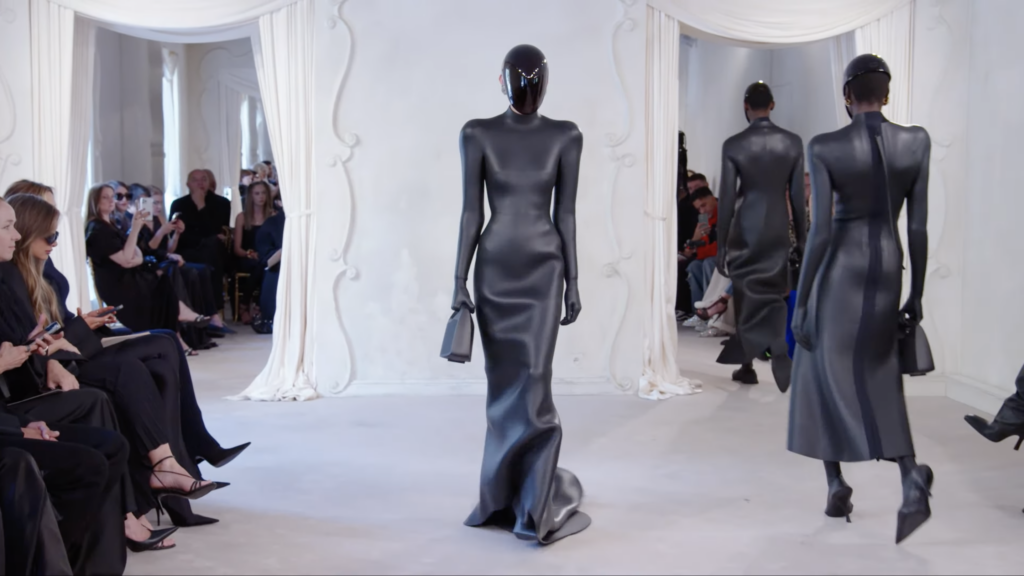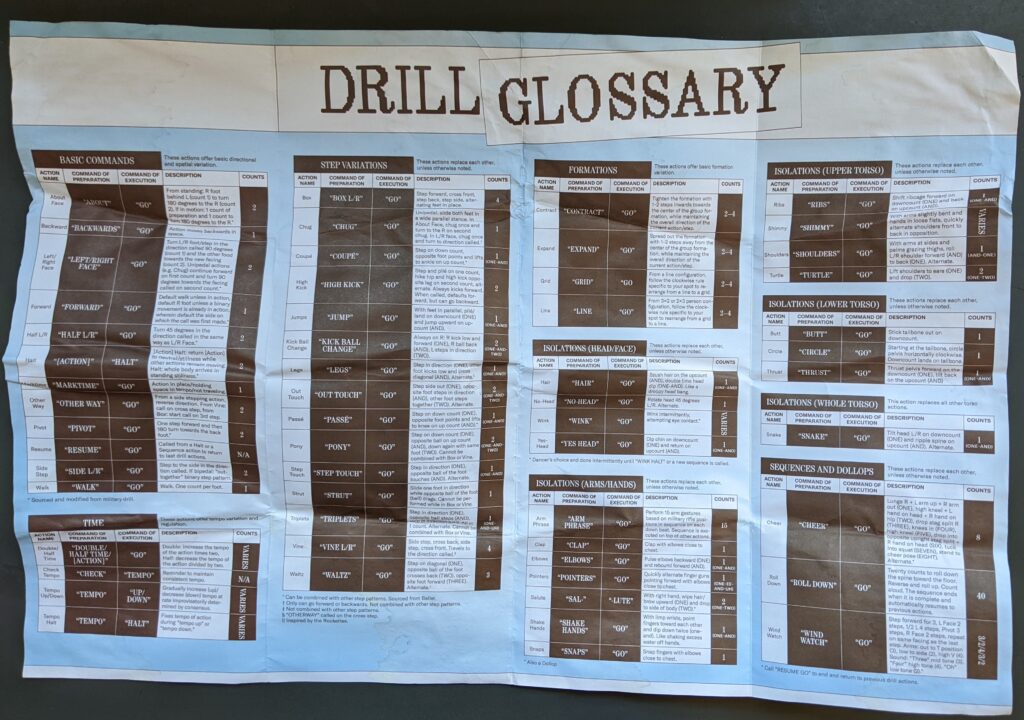For someone who spends most of life reading and writing, dance is a miracle. Literature twists language to get at truth, but dance circumvents it altogether. Of course, this is only true at the moment of performance; the work of dance is full of language–often commands, usually unheard by the audience. Milka Djordjevich’s CORPS, which I saw at NY Live Arts a couple of weeks ago, invites us to consider the interplay of communication and labor in dance. It opens with a two-word command, “Snaps, go,” spoken by one of six dancers in drab gym uniforms as they march into view, fingers obediently snapping. When another says “no-head, go,” they begin to shake their heads, still snapping. This continues, with about forty moves in different combinations—from sources including military drill, ballet, and cheerleading—for the first half of the piece. (My personal favorite was “pointers,” a raffish shaking of double finger-guns that I plan to try at my cousin’s wedding). It’s a strangely anarchic, nonhierarchical performance of command-giving: any dancer can call the next move, and the official vocabulary is interspersed with chatty asides. Controlling their own collective fate, they still end up doing things that none of them seem to want—like jumping up and down for what feels like ten minutes, breathless, awaiting instruction. Anyone who has had a job, or a family, will recognize the inertia of the group project. In the second half, the drill team, now in gold-spangled, softly jingling, not-quite-matching costumes, begins a magnificent disintegration, each dancer interpreting the moves from the first sequence in their own ways, then getting weirder, ultimately collapsing into a pile on the floor. There they chat, all speaking at once, repeating everyday phrases until they morph into new ones (“in or out/in and out/In-N-Out/have you been to In-N-Out?/best burgers…”). This psychedelic segment is a bit more exciting than the flawed austerity that precedes it, but you can’t choose a favorite—each half relies on the other for meaning.
—Jane Breakell, development director
For his 1973 anthology The Oxford Book of Light Verse, W. H. Auden included poetry that took as its subject “the everyday social life of its period or the experiences of the poet as an ordinary human being.” The collection, which includes Byron and Pope, confirms that “lightness” doesn’t preclude “greatness.” I wonder: would Auden consider Tim Key’s Here We Go Round the Mulberry Bush light verse? Certainly, it tackles contemporary social life from the perspective of an everyman—it takes place during COVID lockdown in London, featuring a poet-narrator who traipses around the capital while talking on his iPhone.
The book, subtitled “an anthology of poems and conversations,” is difficult to classify. It has theatrical and fantastical touches, and Key revels in an absurdity that verges on nonsense poetry—but this isn’t that. Maybe if you squint a bit—or a lot—you could call it vers de société. As with Key’s first lockdown anthology, I felt I was encountering a comic novel. It’s a preposterous volume, in which “the Poet” is contemptuous, rash, insecure, ridiculous, and farcically ordinary. His personality comes through so strongly in these pages that it’s easy to imagine him delivering each line, exasperated mumbles and all. Here’s a silly example, from “Leaning”:
The government banned leaning.
“What the -?!”
I could barely believe what I was reading on
www.bbc.co.uk/news/uk
Light verse, indeed, from our Byronic hero! In some happy corner of my mind, Auden is alive, back in that dive on Fifty-Second Street. But this time, he’s not beleaguered by “negation and despair,” and there’s no war in Europe—neither his generation’s nor ours. This time, he’s just reading a bit of Tim Key and giggling.
—Robin Jones, business manager
My love of clothes has always appeared to me merely as a secondary surface effect of another medium—film, photography, music, history—and “style” as a persona—noir heroine, Spring Breaker—with which to accessorize my own personality. I never really liked Fashion, in the proper sense, until I watched Balenciaga’s 51st couture show, which was streamed to the public last week from Paris. The show, staged on snow white carpets in a recreation of Cristobal Balenciaga’s original couture salon, is a mesmerizing dramatization of the gesture of interpretation: Demna Gvasalia’s almost campily pure pageant of Fashion signifies nothing but itself, reducing clothes to abstractions of the medium’s elementary materials—shape, texture, movement.
There’s inflated ballgowns and hyper-architected trench coats, but also T-shirts, the comparative structurelessness of which is illustrated via hyperbolic rumples in the fabric. All of the looks somehow amplify classical silhouettes, either by literally magnifying their proportions, or alienating the form from its fabric. The first half dozen are dresses, suits, and coats rendered in a black rubber that makes them look literally un-textured, like a 3D-model that has yet to be assigned a material. The next couple looks repeat many of the same silhouettes, only “colored in”—with sparkly tweeds, for example. This progression makes these fabrics more sparkly, more tweed-y, more Platonically themselves than they’d otherwise appear.
Much of the show’s dramatic arc is structured by this kind of evolution from ideal to particular. The first thirty-eight models wear shiny, insect-like masks. The various kinds of gimp-y black face coverings that Demna has made his signature have often read to me as embarrassingly “edgy” in their evocation of fetishwear—but in the context of his hyper-couture, the masks don’t “read” at all: instead, they successfully evacuate the clothes of content, allowing them to figure as impersonal animations of Fashion itself. The final models are unmasked, an inversion which elevates their faces into something like masks, casting the real people (many of them celebrities) as iconic versions of themselves.
Rather than digital, everything in the video looks virtual, which is to say perfectly idealized. Watching it on my laptop, I had the uncanny feeling of accessing a world more high-resolution—with cleaner lines, more fabric-like fabrics, more highly characterized characters—than my actual life: muddled, glitchy, pixelated by comparison.
—Olivia Kan-Sperling, assistant editor
from The Paris Review https://ift.tt/zX2AfpZ


Comments
Post a Comment